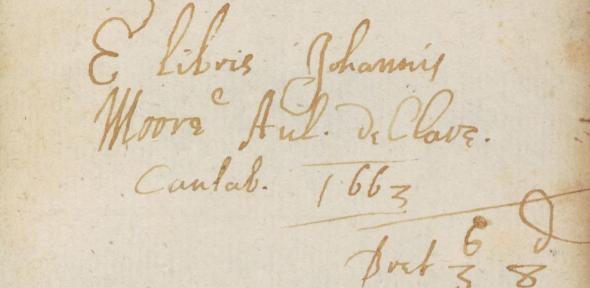
Provenance, that is to say, the past ownership of a book or other collection item, is an important aspect of research for many scholars. This evidence appears in many different forms in the Library's holdings, through book plates, ownership inscriptions, decorations, bindings and annotations. Finding information about former owners can require a variety of resources, and those described below relate to the Library's own holdings. Staff will always be pleased to assist with enquiries. We are also very happy to hear from readers about the provenance evidence they may find while studying books in the Reading Room; much early provenance evidence is not yet recorded in any catalogue, and your help is gratefully received.
For all books catalogued by the Department since 1998, donors, annotators and previous owners of books have been indexed online, with the following identification labels: former owner; donor; depositor; annotator; inscriber; associated name; owner. All such names can be found in iDiscover.
Specific indexes to the provenance of incunabula (books printed before 1500) are also available:
A second online index lists over nine thousand names and ownership marks found in books printed after the incunabula period. This has been compiled from the following sources:
- A partial card catalogue of bookplates, labels and stamps in the Rare Books catalogue annexe. This is confined almost entirely to books acquired by the Library since the 1960s, although a few earlier items have been added when they have been recatalogued.
- A provenance index to printed books in the Library begun by Charles Sayle in 1894 and now available in the Manuscripts Room as MS Add. 6450. This contains many hundreds of entries, but only a very few additions were made since Sayle’s death in 1924.
- A card index to annotators in class Adv. – the Library's main collection of printed books with annotations - in the Rare Books catalogue annexe. This catalogue does not list any notes or marks of ownership in books in other classes in the Library. An annotated copy of H. R. Luard's Catalogue of adversaria and printed books containing MS. notes preserved in the library of the University of Cambridge (Cambridge, 1864) is also available at the Staff Desk; although now largely out of date, this can be of occasional help.
- A list of the Library's armorial bindings in an incomplete file which is otherwise not on public access. Please ask at the Desk if you are interested in tracing a particular armorial binding, and we will check this file for you.
The index is divided into five parts:
About 2,000 entries remain to be added, mostly from books which have changed their shelfmarks since the sources were compiled. The unedited spreadsheet including these additional entries, which will need to be checked against the Library's shelflists, may be found here.
Please bear in mind that the index was compiled from various old unpublished files and matched with books in the online catalogue by an automatic process. It has not been possible to check most of the entries and identifications against the books or other sources, and an entry in this index should not be regarded as authoritative without corroboration. Enquiries, corrections or additional information are welcome; please send them to rarebooks@lib.cam.ac.uk.
The catalogue of the Library by Jonathan Pindar, begun around 1650 and known as the Donors' Book, arranges the contents of the Library chronologically by donors from the fifteenth century to 1658. It was continued by other hands to around 1680, then intermittently to 1718. However, it is by no means comprehensive or, indeed, reliable for the early period. It is available in the Manuscripts Room as MS Oo.7.52. Some autographs in printed books are registered in the catalogue of manuscripts in the Manuscripts Room. While signatures in many modern books are entered there, relatively few are registered from early books. Much useful information on the provenance of particular collections and copies in the Library can be found in Cambridge University Library: a history by J.C.T. Oates and D. McKitterick (B926.2-3); many previous owners are listed in the indexes. Chapter 7 of David Pearson's Provenance research in book history: a handbook (B873.26) includes information on other provenance indexes available in this library and other Cambridge libraries.
The header image shows the ownership annotation of John Moore (1646-1714) when a student in Cambridge. His collection of some 30,000 volumes of books and manuscripts was given to the University by King George I in 1715, trebling the size of the collections. Many of these books are now identifiable primarily through the use of a bookplate added to them by the Library; Moore himself left very few ownership annotations. The collection was celebrated in the 2015 exhibition His Royal Favour: The books that built the Library.
